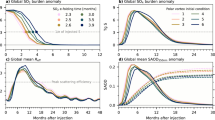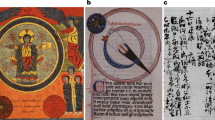Abstract
The widespread evidence for liquid water on the surface of early Mars is difficult to reconcile with a dimmer early Sun. Many geomorphological features suggestive of aqueous activity, such as valley networks and open-basin lakes, date to approximately 3.7 billion years ago1,2,3,4,5, coincident with a period of high volcanic activity5,6. This suggests that volcanic emissions of greenhouse gases could have sustained a warmer and wetter climate on early Mars. However, models that consider only CO2 and H2O emissions fail to produce such climates7,8, and the net climatic effect of the sulphur-bearing gases SO2 and H2S is debated9,10,11. Here we investigate the atmospheric response to brief and strong volcanic eruptions, including sulphur emissions and an evolving population of H2SO4-bearing aerosols, using a microphysical aerosol model. In our simulations, strong greenhouse warming by SO2 is accompanied by modest cooling by sulphate aerosol formation in a presumably dusty early Martian atmosphere. The simulated net positive radiative effect in an otherwise cold climate temporarily increases surface temperatures to permit above-freezing peak daily temperatures at low latitudes. We conclude that punctuated volcanic activity can repeatedly lead to warm climatic conditions that may have persisted for decades to centuries on Mars, consistent with evidence for transient liquid water on the Martian surface.
This is a preview of subscription content, access via your institution
Access options
Subscribe to this journal
Receive 12 print issues and online access
$259.00 per year
only $21.58 per issue
Buy this article
- Purchase on Springer Link
- Instant access to full article PDF
Prices may be subject to local taxes which are calculated during checkout



Similar content being viewed by others
References
Fassett, C. I. & Head, J. W. III The timing of martian valley network activity: Constraints from buffered crater counting. Icarus 195, 61–89 (2008).
Hoke, M. R. T. & Hynek, B. M. Roaming zones of precipitation on ancient Mars as recorded in valley networks. J. Geophys. Res. Planets 114, E08002 (2009).
Hynek, B. M., Beach, M. & Hoke, M. R. T. Updated global map of Martian valley networks and implications for climate and hydrologic processes. J. Geophys. Res. Planets 115, E09008 (2010).
Fassett, C. I. & Head, J. W. III Valley network-fed, open-basin lakes on Mars: Distribution and implications for Noachian surface and subsurface hydrology. Icarus 198, 37–56 (2008).
Goudge, T. A., Head, J. W. III, Mustard, J. F. & Fassett, C. I. An analysis of open-basin lake deposits on Mars: Evidence for the nature of associated lacustrine deposits and post-lacustrine modification processes. Icarus 219, 211–229 (2012).
Carr, M. H. & Head, J. W. III Geologic history of Mars. Earth Planet. Sci. Lett. 294, 185–203 (2010).
Wordsworth, R. et al. Global modelling of the early martian climate under a denser CO2 atmosphere: Water cycle and ice evolution. Icarus 222, 1–19 (2013).
Forget, F. et al. 3D modelling of the early martian climate under a denser CO2 atmosphere: Temperatures and CO2 ice clouds. Icarus 222, 81–99 (2013).
Halevy, I., Zuber, M. T. & Schrag, D. P. A sulfur dioxide climate feedback on early Mars. Science 318, 1903–1907 (2007).
Johnson, S. S., Mischna, M. A., Grove, T. L. & Zuber, M. T. Sulfur-induced greenhouse warming on early Mars. J. Geophys. Res. Planets 113, E08005 (2008).
Tian, F. et al. Photochemical and climate consequences of sulfur outgassing on early Mars. Earth Planet. Sci. Lett. 295, 412–418 (2010).
Malin, M. C. & Edgett, K. S. Evidence for persistent flow and aqueous sedimentation on early Mars. Science 302, 1931–1934 (2003).
Di Achille, G. & Hynek, B. M. Ancient ocean on Mars supported by global distribution of deltas and valleys. Nature Geosci. 3, 459–463 (2010).
Golombek, M. P. & Bridges, N. T. Erosion rates on Mars and implications for climate change: Constraints from the Pathfinder landing site. J. Geophys. Res. Planets 105, 1841–1853 (2000).
Carter, J., Poulet, F., Bibring, J-P., Mangold, N. & Murchie, S. Hydrous minerals on Mars as seen by the CRISM and OMEGA imaging spectrometers: Updated global view. J. Geophys. Res. Planets 118, 831–858 (2013).
Pollack, J. B., Kasting, J. F., Richardson, S. M. & Poliakoff, K. The case for a wet, warm climate on early Mars. Icarus 71, 203–224 (1987).
Head, J. W. III, Kreslavsky, M. A. & Pratt, S. Northern lowlands of Mars: Evidence for widespread volcanic flooding and tectonic deformation in the Hesperian Period. J. Geophys. Res. Planets 107, E001445 (2002).
Tanaka, K. L., Robbins, S. J., Fortezzo, C. M., Skinner, J. A. & Hare, T. M. The digital geologic map of Mars: Chronostratigraphic ages, topographic and crater morphologic characteristics, and updated resurfacing history. Planet. Space Sci. 95, 11–24 (2014).
Head, J. W. III et al. The Huygens–Hellas giant dike system on Mars: Implications for Late Noachian–Early Hesperian volcanic resurfacing and climatic evolution. Geology 34, 285–288 (2006).
Self, S., Thordarson, T. & Keszthelyi, L. in Large Igneous Provinces: Continental, Oceanic, and Planetary Volcanism: Geophysical Monograph Series 100 (eds Mahony, J. J. & Coffin, M.) 381–410 (American Geophysical Union, 1997).
Self, S., Widdowson, M., Thordarson, T. & Jay, A. E. Volatile fluxes during flood basalt eruptions and potential effects on the global environment: A Deccan perspective. Earth Planet. Sci. Lett. 248, 518–532 (2006).
Wilson, L., Scott, E. D. & Head, J. W. III Evidence for episodicity in the magma supply to the large Tharsis volcanoes. J. Geophys. Res. Planets 106, 1423–1433 (2001).
Gaillard, F. & Scaillet, B. The sulfur content of volcanic gases on Mars. Earth Planet. Sci. Lett. 279, 34–43 (2009).
Johnson, S. J., Pavlov, A. A. & Mischna, M. A. Fate of SO2 in the ancient Martian atmosphere: Implications for transient greenhouse warming. J. Geophys. Res. Planets 114, E11011 (2009).
Hoke, M. R. T., Hynek, B. M. & Tucker, G. E. Formation timescales of large Martian valley networks. Earth Planet. Sci. Lett. 312, 1–12 (2011).
Barnhart, C. J., Howard, A. D. & Moore, J. M. Long-term precipitation and late-stage valley network formation: Landform simulations of Parana Basin, Mars. J. Geophys. Res. Planets 114, E01003 (2009).
Tosca, N. J. & Knoll, A. H. Juvenile chemical sediments and the long term persistence of water at the surface of Mars. Earth Planet. Sci. Lett. 286, 379–386 (2009).
Milliken, R. E., Grotzinger, J. P. & Thomson, B. J. Paleoclimate on Mars as captured by the stratigraphic record in Gale Crater. Geophys. Res. Lett. 37, L04201 (2010).
Fastook, J. L. & Head, J. W. III Early Mars climate near the Noachian–Hesperian boundary: Independent evidence for cold conditions from basal melting of the south polar ice sheet (Dorsa Argentea Formation) and implications for valley network formation. Icarus 219, 25–40 (2012).
Ross, P. S. et al. Mafic volcaniclastic deposits in flood basalt provinces: A review. J. Volcanol. Geotherm. Res. 145, 281–314 (2005).
Acknowledgements
We thank M.J. Wolff for insightful comments. I.H. acknowledges support from an Alon Fellowship for Young Principal Investigators from the Israeli Committee for Higher Education, and from the Helen Kimmel Center for Planetary Science at the Weizmann Institute of Science. J.W.H.III acknowledges support from the NASA Mars Data Analysis Program.
Author information
Authors and Affiliations
Contributions
I.H. developed the aerosol microphysics and radiative transfer models, performed the calculations, analysed the results and drafted the main and supplementary text. J.W.H.III provided the geologic evidence for the nature and timing of plains volcanism on early Mars and the association with aqueous activity. Both authors contributed to interpretation of the results and to writing the text.
Corresponding author
Ethics declarations
Competing interests
The authors declare no competing financial interests.
Supplementary information
Supplementary Information
Supplementary Information (PDF 2621 kb)
Rights and permissions
About this article
Cite this article
Halevy, I., Head III, J. Episodic warming of early Mars by punctuated volcanism. Nature Geosci 7, 865–868 (2014). https://doi.org/10.1038/ngeo2293
Received:
Accepted:
Published:
Issue Date:
DOI: https://doi.org/10.1038/ngeo2293
This article is cited by
-
Lacustrine sedimentation by powerful storm waves in Gale crater and its implications for a warming episode on Mars
Scientific Reports (2023)
-
The Mars system revealed by the Martian Moons eXploration mission
Earth, Planets and Space (2022)
-
Chemical weathering over hundreds of millions of years of greenhouse conditions on Mars
Communications Earth & Environment (2022)
-
A coupled model of episodic warming, oxidation and geochemical transitions on early Mars
Nature Geoscience (2021)
-
Deposits from giant floods in Gale crater and their implications for the climate of early Mars
Scientific Reports (2020)



